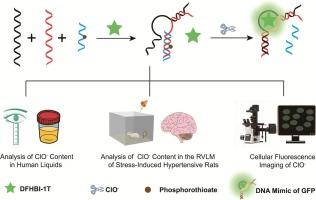A sample fluorescent probe based on DNA aptamer mimic of GFP for “turn-on” sensing of ClO−
IF 4.6
2区 化学
Q1 SPECTROSCOPY
Spectrochimica Acta Part A: Molecular and Biomolecular Spectroscopy
Pub Date : 2025-09-12
DOI:10.1016/j.saa.2025.126941
引用次数: 0
Abstract
Hypochlorous acid (HClO), a significant reactive oxygen species in biological systems, plays a vital role in both physiological and pathological processes. Irregular HClO concentration changes can cause diseases like inflammation, cardiovascular disorders, and neurodegenerative conditions. Thus, creating a method for fast and sensitive ClO− detection is essential for biomedicine and bioassays. This study introduces an innovative fluorescent biosensor for ClO− detection, using a DNA aptamer mimic of green fluorescent protein (DMGFP). By integrating DMGFP with phosphorothioate-modified block DNA, the biosensor achieves a low detection limit of 90.3 nM, with high specificity and a streamlined, cost-effective design. It allows for rapid ClO− analysis in complex biological samples. The method's efficacy was confirmed in tears, urine, and the RVLM tissue of SIH rats, underscoring its clinical and physiological relevance. Additionally, the biosensor demonstrates significant potential in fluorescence imaging, offering a powerful tool for studying oxidative stress-related conditions and disease diagnosis.

一种基于GFP DNA适体模拟物的样品荧光探针,用于ClO−的“开启”感应
次氯酸(HClO)是生物系统中一种重要的活性氧,在生理和病理过程中都起着至关重要的作用。不规律的HClO浓度变化可引起炎症、心血管疾病和神经退行性疾病等疾病。因此,建立一种快速灵敏的ClO -检测方法对生物医学和生物分析至关重要。本研究介绍了一种创新的荧光生物传感器用于ClO -检测,使用绿色荧光蛋白(DMGFP)的DNA适配体模拟物。通过将DMGFP与硫代酸修饰的DNA块整合,该生物传感器的检测限低至90.3 nM,具有高特异性和流线型的低成本设计。它允许在复杂的生物样品快速氯离子分析。在SIH大鼠的眼泪、尿液和RVLM组织中证实了该方法的有效性,强调了其临床和生理相关性。此外,该生物传感器在荧光成像方面显示出巨大的潜力,为研究氧化应激相关疾病和疾病诊断提供了强有力的工具。
本文章由计算机程序翻译,如有差异,请以英文原文为准。
求助全文
约1分钟内获得全文
求助全文
来源期刊
CiteScore
8.40
自引率
11.40%
发文量
1364
审稿时长
40 days
期刊介绍:
Spectrochimica Acta, Part A: Molecular and Biomolecular Spectroscopy (SAA) is an interdisciplinary journal which spans from basic to applied aspects of optical spectroscopy in chemistry, medicine, biology, and materials science.
The journal publishes original scientific papers that feature high-quality spectroscopic data and analysis. From the broad range of optical spectroscopies, the emphasis is on electronic, vibrational or rotational spectra of molecules, rather than on spectroscopy based on magnetic moments.
Criteria for publication in SAA are novelty, uniqueness, and outstanding quality. Routine applications of spectroscopic techniques and computational methods are not appropriate.
Topics of particular interest of Spectrochimica Acta Part A include, but are not limited to:
Spectroscopy and dynamics of bioanalytical, biomedical, environmental, and atmospheric sciences,
Novel experimental techniques or instrumentation for molecular spectroscopy,
Novel theoretical and computational methods,
Novel applications in photochemistry and photobiology,
Novel interpretational approaches as well as advances in data analysis based on electronic or vibrational spectroscopy.

 求助内容:
求助内容: 应助结果提醒方式:
应助结果提醒方式:


